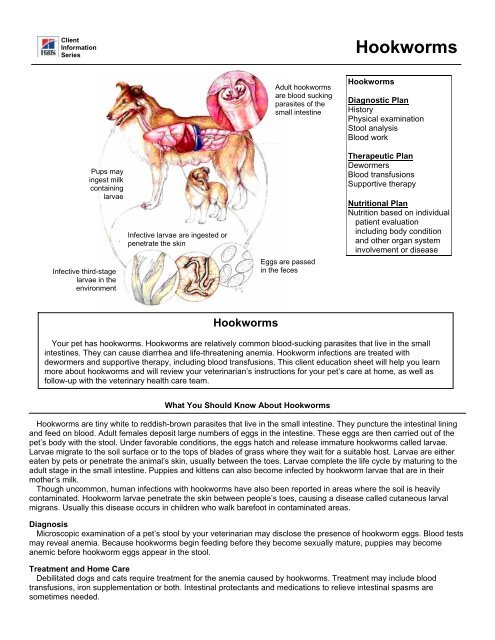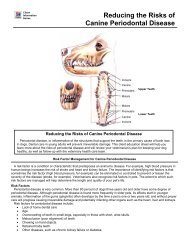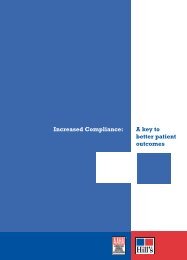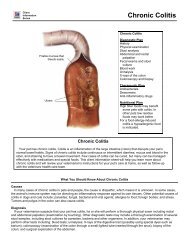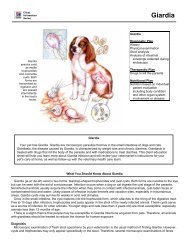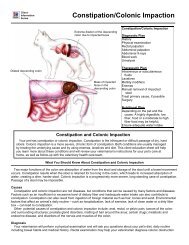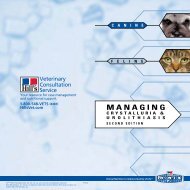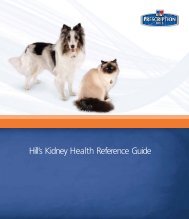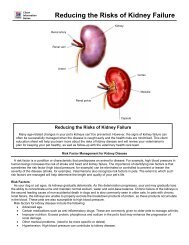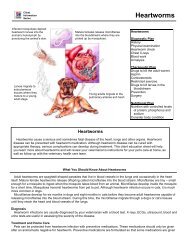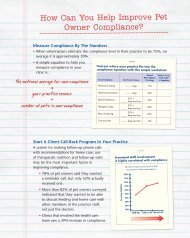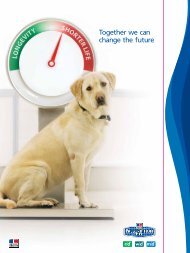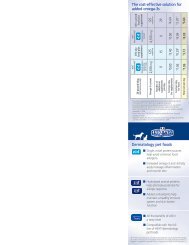Hookworms - HillsVet
Hookworms - HillsVet
Hookworms - HillsVet
Create successful ePaper yourself
Turn your PDF publications into a flip-book with our unique Google optimized e-Paper software.
Client<br />
Information<br />
Series<br />
<strong>Hookworms</strong><br />
Pups may<br />
ingest milk<br />
containing<br />
larvae<br />
Infective third-stage<br />
larvae in the<br />
environment<br />
Infective larvae are ingested or<br />
penetrate the skin<br />
Adult hookworms<br />
are blood sucking<br />
parasites of the<br />
small intestine<br />
Eggs are passed<br />
in the feces<br />
<strong>Hookworms</strong><br />
Diagnostic Plan<br />
History<br />
Physical examination<br />
Stool analysis<br />
Blood work<br />
Therapeutic Plan<br />
Dewormers<br />
Blood transfusions<br />
Supportive therapy<br />
Nutritional Plan<br />
Nutrition based on individual<br />
patient evaluation<br />
including body condition<br />
and other organ system<br />
involvement or disease<br />
<strong>Hookworms</strong><br />
Your pet has hookworms. <strong>Hookworms</strong> are relatively common blood-sucking parasites that live in the small<br />
intestines. They can cause diarrhea and life-threatening anemia. Hookworm infections are treated with<br />
dewormers and supportive therapy, including blood transfusions. This client education sheet will help you learn<br />
more about hookworms and will review your veterinarian’s instructions for your pet’s care at home, as well as<br />
follow-up with the veterinary health care team.<br />
What You Should Know About <strong>Hookworms</strong><br />
<strong>Hookworms</strong> are tiny white to reddish-brown parasites that live in the small intestine. They puncture the intestinal lining<br />
and feed on blood. Adult females deposit large numbers of eggs in the intestine. These eggs are then carried out of the<br />
pet’s body with the stool. Under favorable conditions, the eggs hatch and release immature hookworms called larvae.<br />
Larvae migrate to the soil surface or to the tops of blades of grass where they wait for a suitable host. Larvae are either<br />
eaten by pets or penetrate the animal’s skin, usually between the toes. Larvae complete the life cycle by maturing to the<br />
adult stage in the small intestine. Puppies and kittens can also become infected by hookworm larvae that are in their<br />
mother’s milk.<br />
Though uncommon, human infections with hookworms have also been reported in areas where the soil is heavily<br />
contaminated. Hookworm larvae penetrate the skin between people’s toes, causing a disease called cutaneous larval<br />
migrans. Usually this disease occurs in children who walk barefoot in contaminated areas.<br />
Diagnosis<br />
Microscopic examination of a pet’s stool by your veterinarian may disclose the presence of hookworm eggs. Blood tests<br />
may reveal anemia. Because hookworms begin feeding before they become sexually mature, puppies may become<br />
anemic before hookworm eggs appear in the stool.<br />
Treatment and Home Care<br />
Debilitated dogs and cats require treatment for the anemia caused by hookworms. Treatment may include blood<br />
transfusions, iron supplementation or both. Intestinal protectants and medications to relieve intestinal spasms are<br />
sometimes needed.
Dewormers effectively eliminate hookworms from the intestinal tract. Many veterinarians recommend that a stool<br />
sample be evaluated by microscopic examination one week after the last deworming to make sure the treatment was<br />
effective.<br />
In regions where hookworms are common, pets may need to be confined to areas where sanitation can be practiced to<br />
reduce the chances for reinfection. Feces should be removed from these areas daily, and pet shouldn't be allowed access<br />
to areas where free-roaming animals have bowel movements. Feces should be removed from litter pans daily. Litter pans<br />
should be washed routinely and allowed to dry in direct sunlight.<br />
Regular microscopic examination of your pet’s stool is the best method to ensure that your pet has not been reinfected<br />
with hookworms. Your veterinarian will tell you how often your pet’s stool should be examined. The frequency will depend<br />
on your geographic location.<br />
Nutritional Plan<br />
If your pet has a hookworm infection, your veterinarian may suggest a dietary change based on your pet’s age and body<br />
condition, the degree of diarrhea and anemia and the presence or absence of disease in other organs and body systems.<br />
If your pet has signs of severe parasitism, your veterinarian may give you special feeding instructions. Anemic and<br />
diarrheic patients may benefit from foods with increased levels of protein and energy during the recovery process. Such<br />
foods include Hill’s® Prescription Diet® i/d® Canine and i/d® Feline Gastrointestinal Health.<br />
After your pet’s recovery is complete, your veterinarian may recommend another dietary change. Nutrition is especially<br />
important for optimal growth and proper development of the protective immune system in puppies and kittens. Optimal<br />
nutrition should also reduce the health risks associated with feeding excess levels of nutrients such as calcium and<br />
phosphorus, which could cause skeletal problems, and excess calories, which could cause obesity. Foods formulated for<br />
optimal growth that avoid excess levels of harmful nutrients include Hill’s® Science Diet® brand pet foods.<br />
Transitioning Food<br />
Unless recommended otherwise by your veterinarian, gradually introduce any new food over a seven-day period. Mix<br />
the new food with your pet’s former food, gradually increasing its proportion until only the new food is fed.<br />
If your pet is one of the few that doesn’t readily accept a new food, try warming the canned food to body temperature,<br />
hand feeding for the first few days, or mixing the dry food with warm water (wait ten minutes before serving). Feed only<br />
the recommended food. Be patient but firm with your pet. This is important because the success or failure of treatment<br />
depends to a large degree on strict adherence to the new food.<br />
Presented as an educational service by<br />
Client’s Name:<br />
Patient’s Name:<br />
Medication(s):<br />
Home Care Instructions<br />
_________________________________________________________<br />
_________________________________________________________<br />
_________________________________________________________<br />
Nutritional Recommendation: ___________________________________________________<br />
Follow-Up Appointment: _______________________________________________________<br />
(Hospital Stamp Area Above)<br />
REGULAR VISITS WILL HELP OUR VETERINARY HEALTH CARE TEAM PROVIDE FOR YOUR PET’S BEST INTEREST.<br />
©2011 Hill’s Pet Nutrition, Inc.<br />
®/ Trademarks owned by Hill’s Pet Nutrition, Inc.


